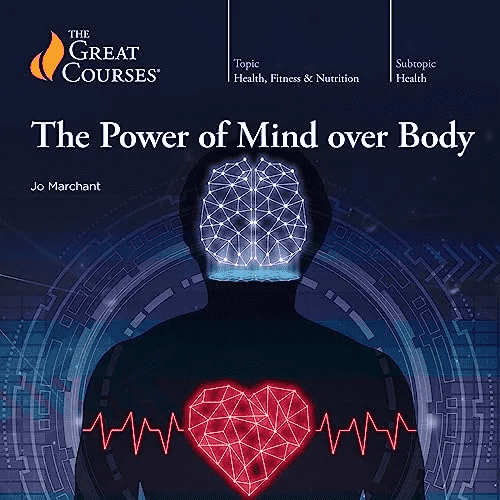The Power of Mind over Body
I had an opportunity to take a 12-lecture course offered by The Great Courses, titled “The Power of Mind Over Body” by Jo Marchant, Ph.D. As the name implies, it discusses the connection between the brain and the body and explores the science behind phenomena like the placebo effect, hypnosis, pain, fatigue, and stress. I personally enjoyed the course, as these common day-to-day phenomena are analyzed scientifically. Explanations are provided that rationalize how certain things are perceived, function, and eventually get done.
We begin the course with the placebo effect, even though some medical professionals might dismiss this effect. But it is a real phenomenon. The placebo effect is where a patient experiences genuine improvement in their symptoms after receiving a treatment that has no therapeutic effect. This can occur because the patient believes that the treatment will help them, even though the treatment itself may be inert, like a sugar pill. The belief in the efficacy of the treatment can cause actual physiological changes, even though the treatment itself has no inherent medical properties. This effect has been observed in various clinical trials and is often used as a control when testing new medications.
Jo Marchant gives various examples, such as a patient who believed they underwent surgery on their backbone and got better, despite no surgery being performed. There are numerous examples where belief in the underlying treatment is more than enough to heal, revealing the biology of the placebo effects.
In the 1970s, scientists discovered naturally occurring substances in the brain called endorphins, which ease pain. Morphine and other synthetic drugs work by mimicking these endorphins. A significant breakthrough came about when John Levine realized that the same effect could be accomplished through the placebo effect. In his experiment, he gave salt water to patients after a dental procedure, and their pain diminished. When he added naloxone, a drug that blocks endorphin receptors, to the salt water, the placebo effect went away.
This astonishing outcome not only showed the authenticity of the placebo effect but demonstrated its physiological effects on our body. The experiment conducted in 1978 proved that the placebo effect could be blocked with naloxone. Whether through morphine or a placebo pill, the goal was to activate certain biochemical pathways. It was the first study to show that placebo effects work through measurable biological mechanisms, concluding that a thought or belief can trigger a biological effect or activate biochemical pathways. This has now been scientifically proven.
Since that study, through PT scans and fMRI scans, we have seen that with the placebo effect, fewer opioid receptors are available, proving that those receptors are being used and there is reduced pain-related activity in the brain. It’s now a scientific fact that the placebo effect has a significant influence on our body. This phenomenon is not just limited to placebo effects.
In numerous studies, if patients were not told that they were given a pain reliever, the effect of that pain reliever was significantly less because those chemical pathways were not activated. We must know that we are getting the pain relief because half the game is knowing that we’re getting the medication. Without knowing that we are receiving a pain reliever, we might not even benefit from it.
When we take a painkiller at home, there are two components to it: our belief in the drug and the chemical reactions from the drug. Both must work for the drug to be effective. In our brain, it can activate opioid receptors, and some placebo can activate cannabinoid receptors. The activation isn’t just limited to opioid receptors; placebos can work through at least two different neural pathways. They can even affect the release of dopamine.
Our beliefs create our biology. An example of this is when people were given fake oxygen at higher altitudes, and the effects were the same as if they had received real oxygen. All the physiological effects were triggered, although no real oxygen was administered. Through the placebo effect, endorphins, dopamine, and other chemicals or neurotransmitters can be released.
We don’t need a physical drug to have a physical effect, and the placebo effect is triggered by the patient’s expectations, previous experiences, and impressions of the treatment. If they believe in it and have positive expectations and previous good experiences, the chances of it working are significantly higher, even if it’s a placebo. Human interaction during treatment is also important.
However, the placebo effect works best in pain scenarios, where it can mitigate pain but not cure the underlying disease. For example, Alzheimer’s cannot go away just by the placebo effect. While temporary pain can be alleviated, the underlying disease remains unaffected. However, easing symptoms is a good enough reason to consider the placebo effect since many drugs treat symptoms without addressing the underlying disease.
Studies comparing placebos with drugs have shown astonishing results, like antidepressants, including Prozac, having little effect above placebo. Even popular drugs like Valium have no effect unless the patient knows they are taking it. A significant study concluded that 75% of the effectiveness of a drug comes from the placebo effect, and only 25% from the drug itself. Believing in the drug accounts for two-thirds of the whole equation, while the drug itself is only one-third. In 2013, new painkillers beat placebos by just 9%, with patients having significant pain reduction. Almost all of it was because of the mind’s influence.

